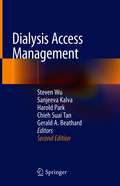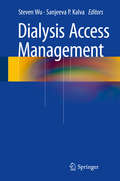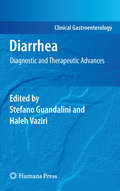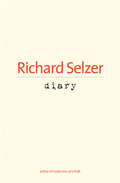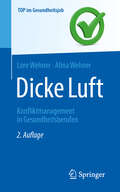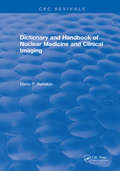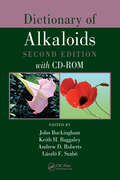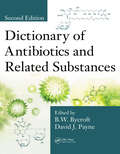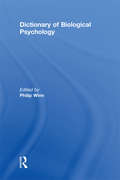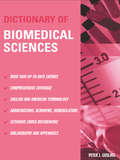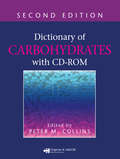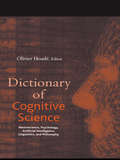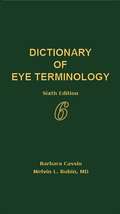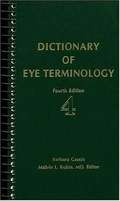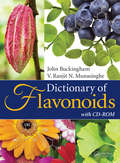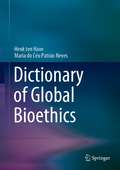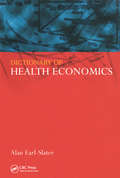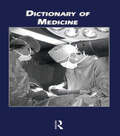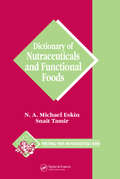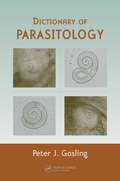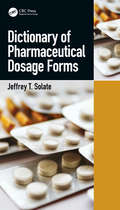- Table View
- List View
Dialysis Access Management
by Steven Wu Gerald A. Beathard Sanjeeva Kalva Harold Park Chieh Suai TanThis updated volume covers the basic principles and practice of dialysis access management. To cover the latest trends and evidence from clinical trials, new chapters on the management of cephalic arch stenosis and swing zone stenosis, the role of drug eluting balloon in dialysis access interventions, the management of central vein stenosis, endovascular creation of AVF, and the management of steal syndrome have been included. Dialysis Access Management gives readers a step-by-step guide to endovascular interventions with special emphasis on the principles and rationale behind these approaches. This book is an essential text for residents, fellows, and physicians who are learning or practicing in dialysis, especially in the fields of nephrology, radiology, surgery, and vascular medicine.
Dialysis Access Management
by Steven Wu Sanjeeva P. KalvaThis practical book covers the basic principles and practice of dialysis access management, a crucial part of the care of patients undergoing hemodialysis. It has been written in an easy-to-read, step-by-step format to help facilitate learning and understanding of the procedures and has been supplemented with numerous operative photographs and diagrams demonstrating the commonly performed dialysis access exams, interventions, procedures and surgeries. Dialysis access management is an essential text for residents, fellows and physicians who are learning or practicing in dialysis and/or dialysis access management, especially in the fields of nephrology, radiology, surgery and vascular medicine.
Dialysis in Older Adults
by Madhukar MisraThis practical handbook offers quick and sound advice on the many issues faced when dialyzing the older patient. It is authored by well-known international experts who have covered the full range of end stage renal disorders including treatment options, patient management and maximization of quality of life. Accessible and easy-to-read, Dialysis in Older Adults serves as the go-to reference for clinicians and members of their team as they treat this challenging patient population.
Diarrhea
by Haleh Vaziri Stefano GuandaliniThis volume provides in a conveniently accessible package a comprehensive collection of accurate and timely information on the management of patients with diarrhea, both in pediatric age and in the adult. As medical knowledge has recently expanded in this area, this volume is full of new practical, clinically useful material for the busy clinician. Illustrations are emphasized to permit rapid acquisition of practical information that is not readily available in the major texts. Each chapter is concise, concentrating on "clinical pearls," and new advances in diagnostic and therapeutic technology. Each chapter discusses the relative costs of diagnostic and therapeutic options to permit financial considerations to be taken into account in the decision making process. Additional unique features include, summaries of key points, recommendations, and indications for requesting GI subspecialty consultation. Providing a comprehensive but practical overview of the issues surrounding the diarrheal diseases, this volume will prove of great value and utility to gastroenterologists, surgeons, internists, primary care physicians.
Diary
by Richard SelzerSusan Cheever observed in a New York Times Book Review appraisal of his memoir Down from Troy that Richard Selzer "cares more about truth than consequences . . . [and] immerses us in the facts we all know but hate to admit. " Selzer's Diary picks up roughly where the memoir leaves off, as his writing life flourishes and surgical career ends. Stripped of the doctor-writer's "privilege of [walking] about all day in the middle of a short story," Selzer shifts his focus to his interior life. InDiary, the author's successes and regrets, as well as the humor and sadness that surround him, are revealed with the same empathy and vividness that made him one of the great doctor-writers of modern literature. Diary brings together stories and observations dashed off on park benches and in library carrels over the past decade. Following the success of such books as Confessions of a Knife and The Doctor Stories, Selzer's diary entries recount life lived in the shadow of both achievement and disappointment. He introduces a varied cast of characters, from the distinguished fellowship of the "Boys Friendly" to his "fellow loonies," and evokes the streets, buildings, and parks of Yale and New Haven with vibrancy and affection. And throughout, Selzer faces the looming specter of old age. The distinctive voice that paved the way for other notable doctor-writers like Jerome Groopman and Abraham Verghese is revealed here to be no less compelling with the spotlight turned on himself and the drama of everyday living.
Diatom Microscopy (Diatoms: Biology and Applications)
by Richard Gordon Nirmal MazumderDIATOM MICROSCOPY The main goal of the book is to demonstrate the wide variety of microscopy methods being used to investigate natural and altered diatom structures. This book on Diatom Microscopy gives an introduction to the wide panoply of microscopy methods being used to investigate diatom structure and biology, marking considerable advances in recent technology including optical, fluorescence, confocal and electron microscopy, surface-enhanced Raman spectroscopy (SERS), atomic force microscopy (AFM) and spectroscopy as applied to diatoms. Each chapter includes a tutorial on a microscopy technique and reviews its applications in diatom nanotechnology and diatom research. The number of diatomists, diatom research, and their publications are increasing rapidly. Although many books have dealt with various aspects of diatom biotechnology, nanotechnology, and morphology, to our knowledge, no volume exists that summarizes advanced microscopic approaches to diatoms. Audience The intended audience is academic and industry researchers as well as graduate students working on diatoms and diatom nanotechnology, including biosensors, biomedical engineering, solar panels, batteries, drug delivery, insect control, and biofuels.
Dicing with Death: Chance, Risk and Health
by Stephen SennIf you think that statistics has nothing to say about what you do or how you could do it better, then you are either wrong or in need of a more interesting job. Stephen Senn explains here how statistics determines many decisions about medical care, from allocating resources for health, to determining which drugs to license, to cause-and-effect in relation to disease. He tackles big themes: clinical trials and the development of medicines, life tables, vaccines and their risks or lack of them, smoking and lung cancer and even the power of prayer. He entertains with puzzles and paradoxes and covers the lives of famous statistical pioneers. By the end of the book the reader will see how reasoning with probability is essential to making rational decisions in medicine, and how and when it can guide us when faced with choices that impact on our health and even life.
Dicke Luft - Konfliktmanagement in Gesundheitsberufen (Top im Gesundheitsjob)
by Lore Wehner Alina WehnerAngehörige von Gesundheitsberufen sind durch ständige Veränderungsprozesse, Personalmangel, komplexe Dokumentationspflichten sowie den hohen Qualitätsmaßstäben und Haftungsrisiken einem steigenden Erwartungsdruck ausgesetzt. So sind vermehrt Konflikte durch Überforderung, Leistungsdruck, gesetzlichen und innerbetrieblichen Vorgaben zu beobachten. Die Konfliktebenen sind vielfältig und reichen von der Führung, über das Team und andere Berufsgruppen bis hin zum Patienten, Kunden und den Angehörigen. Besonders im Berufsalltag wirken sich ungelöste Konflikte und schwelende Konfliktpotenziale nicht nur auf das Wohlbefinden des Einzelnen aus, sondern werden rasch zum Kostenfaktor für das gesamte Unternehmen. Häufige Krankenstände, verminderte Leistungsfähigkeit, Mobbing, Burnout, hohe Personalfluktuation und Imageverlust sind nur einige Folgeerscheinungen. Die erfahrene Autorin stellt in diesem Buch speziell auf den Gesundheits- und Krankenpflegebereich abgestimmte Methoden zur Konfliktbearbeitung und -prävention vor. Fallbeispiele und Erfahrungsberichte geben Einblick in die Praxis. Der Leser erfährt Möglichkeiten, Chancen und Grenzen gewaltfreier, nonverbaler und interkultureller Kommunikation und Konfliktlösungsstrategien. Verschiedene Lösungsansätze wie z.B. Einzelgespräch, Teamgespräch und Mediation werden vorgestellt und die Vor- und Nachteile erläutert. Das neuartige Konfliktlotsenmodell gibt einen Ausblick wie zukünftig Konflikte kreativ bewältigt werden können..
Dictionary and Handbook of Nuclear Medicine and Clinical Imaging
by Mario P. IturraldeThis impressive dictionary/handbook presents the nomenclature characteristic of nuclear medicine, explaining the meaning and current usage of a large variety of terms. It is designed as a ready-to-use and simple guide, arranged in alphabetical order with additional basic information assembled in the appendices. The single volume offers a look into the multidisciplinary world of this specialty. The field of nuclear medicine has emerged as an integrated medical discipline. It is an example of the convergence of many scientific disciplines with those of medicine emphasizing the use of radionuclides in research, diagnosis and therapy. The dictionary/handbook will be of importance to individuals in nuclear medicine and the following fields: physics, instrumentation, techniques, computers, radiopharmacology and radiopharmacy, radioimmunoassay, radiobiology and radiation protection, quality control, math and statistics, nuclear science and technology, radiology, ultrasound, and nuclear magnetic resonance.
Dictionary of Alkaloids
by John Buckingham Andrew D. Roberts Keith H. Baggaley László F. SzabóWhile some of the most commonly investigated- and most notorious- chemicals in the world are alkaloids, many modern medicines are also based on alkaloid structures. Chemists continue to explore new synthetic routes and alkaloid derivatives in search of drug candidates for fighting disease. Drawn from the venerable Dictionary of Natural Products, th
Dictionary of Antibiotics and Related Substances: Second Edition
by Barrie W. Bycroft David J. PayneBacterial and parasitic diseases are the second leading cause of death worldwide, according to a report by the London School of Economics. Due to the emergence of drug-resistant "superbugs," like methicillin-resistant Staphylococcus aureus (MRSA), traditional antibiotics such as penicillin and its derivatives are in danger of becoming obsolete. In an effort to combat this problem, pharmaceutical companies continue to research new and effective antibiotics.The Dictionary of Antibiotics and Related Substances, Second Edition is a definitive reference work dealing with this crucially important class of biochemicals. It consists of a comprehensive survey of the antibiotic field, providing a single-volume resource and a significant update to the first edition published in 1988. Each dictionary entry contains the chemical name and synonyms, CAS Number, chemical structure, biological activity, and a concise bibliography.Entries include naturally occurring antibiotics, such as the beta-lactams (penicillins, cephalosporins, and carbapenems) and aminoglycosides; semisynthetic antibiotics—the most common type available—modified chemically from original compounds found in nature; and synthetic antibiotics, including the sulfonamides, the quinolones, and the oxazolidinones. It is estimated that there are approximately 10,000 antibiotics known, and this revised edition of the successful compilation covers all of the different classes. The dictionary also includes fully searchable downloadable resources.
Dictionary of Biological Psychology
by Philip WinnBiological Psychology is the study of psychological processes in terms of biological functions. A major obstacle to understanding dialogue in the field has always been its terminology which is drawn from a variety of non-psychological sources such as clinical medicine, psychiatry and neuroscience, as well as specialist areas of psychology such as ethology, learning theory and psychophysics. For the first time, a distinguished international team of contributors has now drawn these terms together and defined them both in terms of their physical properties and their behavioural significance.The Dictionary of Biological Psychology will prove an invaluable source of reference for undergraduates in psychology wrestling with the fundamentals of brain physiology, anatomy and chemistry, as well as researchers and practitioners in the neurosciences, psychiatry and the professions allied to medicine. It is an essential resource both for teaching and for independent study, reliable for fact-checking and a solid starting point for wider exploration.
Dictionary of Biomedical Science
by Peter J. GoslingDo you want to know what inherited defect causes thalassaemia? Do you understand the significance of "resistance" when applied to microbiology? Can you say what a "frozen section" really is? The Dictionary of Biomedical Sciences answers all these questions and more. This informative, practical guide contains over 8000 entries that define all the ba
Dictionary of Carbohydrates
by Peter M. CollinsAn easy-to-use reference source for all scientists working with carbohydrates, the Dictionary of Carbohydrates with CD-ROM, Second Edition builds on the success of its previous edition by providing a substantially increased number of compounds. The presentation is sharpened by a careful review of existing entries. With 24,000 compounds, it represen
Dictionary of Cognitive Science: Neuroscience, Psychology, Artificial Intelligence, Linguistics, and Philosophy
by Olivier HoudéA translation of the renowned French reference book, Vocabulaire de sciences cognitives , the Dictionary of Cognitive Science presents comprehensive definitions in more than 120 subjects. Topics range from 'Abduction' to 'Writing', and each entry is covered from as many perspectives as possible within the domains of psychology, artificial intelligence, neuroscience, philosophy, and linguistics. The editor and his advisory board, each a specialist in one of these areas, have brought together 60 internationally recognized scholars to give the reader a comprehensive understanding of the most current and dynamic thinking in the cognitive sciences.
Dictionary of Disaster Medicine and Humanitarian Relief
by S. William GunnThe 2nd edition of the Dictionary of Disaster Medicine and Humanitarian Relief is an essential and practical reference for all those who work in humanitarian relief. This new, expanded edition presents more than 3000 definitions and acronyms covering the entire multidisciplinary scope of disaster medicine and humanitarian relief, as well as new fields such as climate change and bioterrorism. As natural disasters, humanitarian emergencies, and infectious disease epidemics increase in frequency and seriousness, this book is an important reference to assist international relief workers communicate with each other and with the media. The author has served as both the director of Emergency Humanitarian Operations of the World Health Organization, as well as the WHO's chief of scientific terminology. As the Director-General Emeritus of the World Health Organization says in the Foreword, "This new expanded edition comes as a timely essential aid against the growing threats of inhuman violence and destructive disasters."
Dictionary of Eye Terminology
by Barbara Cassin Melvin L. RubinThis new edition has been expanded with more terms and more abbreviations. Here are more than 5,000 of the most frequently used terms and phrases associated with the eye and vision, and 1,000 abbreviations and acronyms. Definitions are in "plain English" so everyone can understand them. SPECIAL FEATURES include mini-definitions within definitions (you don't need to chase down a cross-reference), phonetic pronunciations, and actual misspellings in the alphabetical listings, so you don't need to spell a word correctly to find it.
Dictionary of Eye Terminology, 4th Edition
by Barbara Cassin Melvin L RubinThis comprehensive reference has been written for the purpose of making ophthalmological terminology comprehensible to the person without a scientific background.
Dictionary of Flavonoids
by John Buckingham V. Ranjit MunasingheWidely distributed throughout plant families, flavonoids give many flowers and fruits their vibrant colors. They also play a role in protecting the plants from microbe and insect attacks. More importantly, the consumption of foods containing flavonoids has been linked to numerous health benefits. Recent research indicates that flavonoids can be nutritionally helpful by triggering enzymes that reduce the risk of certain cancers, heart disease, and age-related degenerative diseases. Foods that contain high amounts of flavonoids include blueberries, red beans, cranberries, and blackberries. Many other foods, including red and yellow fruits and vegetables and some nuts, as well as red wine and certain teas are also rich in flavonoids.Due the potential health benefits, research into flavonoids and their potential beneficial effects on human health continues unabated. Dictionary of Flavonoids with downloadable resources lists all known flavonoids (approximately 13,000) in a single volume. It details chemical structures, physical properties, and biological source, and also includes a concise bibliography. Derived from the well-respected Dictionary of Natural Products, it is presented in a compact dictionary format, and is an invaluable reference source for all those working in this area. The book is accompanied by downloadable resources that are fully searchable by chemical structure as well as by physical properties and chemical names.Organized in alphabetical order, each page is packed with authoritative information that readers can easily access. The book and downloadable resource combination gives researchers powerful tools for unlocking and utilizing the secrets held within the colors of the plant kingdom.
Dictionary of Global Bioethics
by Henk ten Have Maria do Patrão NevesThis Dictionary presents a broad range of topics relevant in present-day global bioethics. With more than 500 entries, this dictionary covers organizations working in the field of global bioethics, international documents concerning bioethics, personalities that have played a role in the development of global bioethics, as well as specific topics in the field.The book is not only useful for students and professionals in global health activities, but can also serve as a basic tool that explains relevant ethical notions and terms. The dictionary furthers the ideals of cosmopolitanism: solidarity, equality, respect for difference and concern with what human beings- and specifically patients - have in common, regardless of their backgrounds, hometowns, religions, gender, etc. Global problems such as pandemic diseases, disasters, lack of care and medication, homelessness and displacement call for global responses.This book demonstrates that a moral vision of global health is necessary and it helps to quickly understand the basic ideas of global bioethics.
Dictionary of Health Economics
by Alan Earl-SlaterComprehensive, concise and easily accessible, this is the first health economics dictionary of its kind and is an essential reference tool for everyone involved, or interested in, healthcare. The modern terminology of health economics and relevant terms used by economists working in the fields of epidemiology, public health, decision management and policy studies are all clearly explained. Combined with hundreds of key terms, the skillful use of examples, figures, tables and a simple cross-referencing system between definitions, allows the often complex language of health economics to be demystified.
Dictionary of Medicine
by P. H. CollinFirst Published in 1999. This dictionary provides the user with the basic vocabulary used in British and American medical practice. The subject matter covers terms used in surgery, general practice, hospitals, nursing, pharmacy, dentistry and other specializations. The level of language varies from the very technical to informal usage as between professionals or between professionals and patients. Each of the 12,000 headwords is defined in simple English, using a limited vocabulary of 500 words over and above those words which actually appear in the dictionary as main words. At the back of the book are a series of supplements which give useful information in tabular form: these refer to vitamins, incubation periods, SI equivalents, diets, and notes on eponymous words.
Dictionary of Nutraceuticals and Functional Foods
by Michael Eskin Snait TamirHealth professionals are recognizing the major role that nutraceuticals play in health enhancement. As a result, there is a dramatic increase in research aimed at identifying new functional foods and nutraceuticals. There is not, however, a single source that presents this research in a thorough and accessible manner. Comprehensive and complete, th
Dictionary of Parasitology
by Peter J. GoslingAlthough many books have been published on various aspects of human, animal, and plant parasitology, as well as the public health problems associated with parasites, none to date has offered a comprehensive glossary for those confronted with the discipline's exceptionally extensive terminology. To meet this need requires a dedicated text that can h
Dictionary of Pharmaceutical Dosage Forms
by Jeffrey T. SolateThe study of pharmaceutical dosage forms has many connections to biological and medical sciences including physiology, biochemistry, pharmacology, pharmacotherapy, therapeutics, pharmacodynamics, pharmacokinetics, and pharmacognosy. Dictionary of Pharmaceutical Dosage Forms is a collection of terms and definitions prepared to assist healthcare practitioners and students as a companion or reference resource when reading notes and completing routine care. It can also provide reference material for hospital and medical staff, consultants, nursing instructors, and pharmaceutical science students. This first edition classifies and organizes the forms in an easily readable format, so readers will find it a quick and simple reference. Features Collects terms and definitions to assist healthcare practitioners and students as a companion or reference resource when reading notes and completing routine care Focuses on product dosage forms and includes supplementary information, providing readers, particularly pharmacy and medical students and professionals, insights into choices of dosage forms made during drug product development Offers information on the indications, contraindications, side effects, and more, for a given drug Classifies and organizes the forms in a readable format, providing a quick and simple reference
